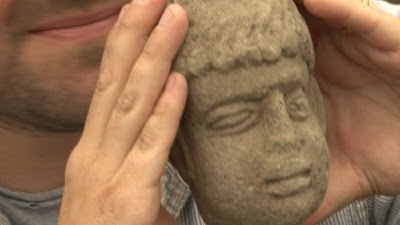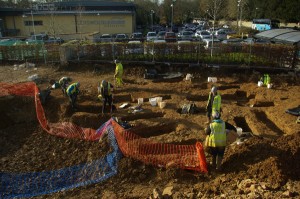The Roman Archaeology Blog is concerned with news reports featuring Roman period archaeology. If you wish to see news reports for general European archaeology, please go to The Archaeology of Europe Weblog.
Friday, July 26, 2013
Roman mosaic may lie beneath Chester’s Dewa Experience building
ARCHAEOLOGISTS says there is the tantalising prospect of a Roman mosaic beneath the Dewa Roman Experience premises in the city centre.
A ongoing dig Pierpoint Lane site, off Bridge Street, has so far exposed an eight metres section of Roman wall next to a courtyard along with the remains of a flue.
The wall would have formed part of a building, of unknown purpose, leading to speculation about what may lie behind the wall in the centre of the former premises.
Archaeologist Mike Emery has been told by building owner Peter Dentith that someone who helped construct the 1960s building on the site insists a Roman mosaic was found at the time “but quickly covered up”.
Read the rest of this article...
Archaeologists Excavate Ancient Roman Capital in Macedonia
Although the ancient site known as Stobi in central Macedonia has been the subject of numerous excavations and research over the past century, only 15- 20 percent of its remains have been uncovered. Since 2008, however, renewed excavations under the auspices of the Balkan Heritage Foundation have been busy opening a new window on an ancient Roman city that, for a time, was a major center of trade and commerce.
Now, a team of archaeologists, students and volunteers will be returning to the site in August of 2013 to continue unearthing the northern residential section of the city, near a center that has already yielded such remains as a large theater, a city wall, a forum, a synagogue, a baptistry and a water supply system. During recent excavation seasons archaeologists have uncovered evidence of a necropolis (in use from the 1st century BC to the 5th century AD) and an ancient temple dated to the 2nd and 3rd centuries AD. Write the project directors about their plans: "The excavations in 2011 and 2012 were focused on the Northern Residential Area of Ancient Stobi, inhabited from the Late Hellenistic till the Late Roman period. Further excavations at the same area are planned for next season in conjunction with the efforts of the National Institute (NI) Stobi in order to preserve and display this part of the site. The layers to be studied in 2013 mainly include the Roman and Late Roman periods of the existing ancient neighborhood."*
Read the rest of this article...
Friday, July 19, 2013
Corinium’s dead – Excavating Cirencester’s Tetbury Road Roman cemetery
Recent excavations just beyond the walls of Roman Cirencester revealed the unexpected survival of parts of a town cemetery. Neil Holbrook, Ed McSloy and Jonny Geber explained to Matthew Symonds the results of our best glimpse of Corinium’s occupants for 40 years.
It started as a watching brief in 2011. Although Bridges Garage in Cirencester was known to lie on the site of a former Roman cemetery, it was believed that deep petrol tanks had long since destroyed any archaeology. When the garage was originally built in the 1960s on open ground beside Tetbury Road, in Cirencester’s western outskirts, it triggered salvage recording by Richard Reece. He managed to record 46 cremation burials and eight inhumations as the site was dug away around him. Fiftyyears later, as the bulldozers rolled in once more, it quickly became apparent that pockets of the Roman cemetery had survived intact. Cotswold Archaeology duly assembled an excavation team.
Read the rest of this article...
Roman dig in Maryport reveals ancient temple
Archaeologists at a Roman dig in Maryport have been showing off what they have found in their third year of excavations on the site.
The team, from the Senhouse Museum Trust and Newcastle University, have two years of work left to do.
Professor Ian Haynes, from Newcastle University said:
"We've opened three trenches here at Marport this year and we are currently in the trench that has opened up a classic Roman temple.
"It is the finest classical temple in the north-west of England. In fact it is the north-western most Classic temple in the Roman world."
Read the rest of this article...
Monday, July 15, 2013
Roman mosaics discovered in Amasya
Archaeological excavations in theBlack Sea province of Amasya have revealed 2,000-year-old mosaics with kilim-like motifs that are believed to date back from the Roman period.
The excavations are being carried out by the Amasya Museum Directorate in the Yavru village. Officials said that the mosaics with kilim motifs were “unique.”
Çorum-based Hitit University Black Sea Archaeology Research and Practice Center Deputy Director Associate Professor Esra Keskin said the mosaics that had been found in a palace-like place had a different design when compared to the other artifacts in the same era.
Read the rest of this article...
‘Call in Time Team to discover Grimescar Wood’s Roman secret’
COULD there be a Roman settlement buried under a Huddersfield wood?
Archaeology enthusiast Stephen Priest, of Aspley, believes Grimescar Wood, near Birkby, could hide an ancient secret.
A kiln from around 100AD was first found by colliers in 1580 and then rediscovered in 1955 by school pupils.
Indeed an archaeological dig in 1964 uncovered ancient bowls, flagons and jars.
Read the rest of this article...
Construction Magnate Donates Millions To Restore Pompeii As UNESCO Criticises Italian Government
Italian construction magnate Pietro Salini wants to donate €20 million to restore Pompeii.
Reuters news agency reports that Salini wants to donate funds to restore the archaeological site that has been damaged by weather, and has suffered from corrupt management and mafia interference. Salini aims to attract other international donors to restore the Ancient Roman city, telling a press conference: “It would be a crime to let Pompeii crumble.”
Salini’s announcement comes at a time when the head of the UNESCO National Commission in Italy, Giovanni Puglisi, warned the Italian government that it needs to accelerate ongoing restoration work at the archaeological site, saying the government “has until 31 December to adopt suitable measures for Pompeii”. In January 2013, UNESCO documented structural problems and damage Pompeii. UNESCO is due to make a progress assessment in February 2014.
Puglisi cited “irregular buildings not included in the previous plan and a lack of personnel” at the site. He called for “a new observance zone” around the site to protect it from illegal construction infringing the area.
Read the rest of this article...
Wednesday, July 10, 2013
Unearthed Late Roman well may have modern-day significance
Archaeologists from the University of York say a virtually intact Late Roman well discovered near Heslington, on the outskirts of the city, may have had significance in contemporary local agricultural cycles and fertility practices.
The well, which is thought to have been in use for several decades in the late 4th and early 5th centuries, was unearthed during archaeological excavations on the site of the University's campus expansion at Heslington East.
From at least the Early Bronze Age, a range of methods were used here to access natural springs, including watering holes and primitive wells. In contrast, this Late Roman feature was carefully engineered, positioned high on a hillside and used newly acquired, good-quality masonry.
Read the rest of this article...
Sunday, July 7, 2013
Roman villa to serve tourism
Workers clean the mosaics during restorations in the Roman villa. AA Photo
Mosaics in a villa from the late Roman period, found five years ago in a green area, are undergoing restoration works. The mosaics depict the figure of a women, sitting among bunches of grapes, and a man with a dagger in his hand trying to kill her.
The restoration started with four experts and 12 workers headed by the Director of the Ereğli Museum Ahmet Mercan and archaeologist Ünver Göçen. After a one-month restoration and cleaning process, the mosaics will be covered and the area will open to tourists.
Read the rest of this article...
Archaeologists unearth carved head of Roman god in ancient rubbish dum
Dr David Petts on site with the Binchester head
An 1,800-year-old carved stone head of what is believed to be a Roman god has been unearthed in an ancient rubbish dump.
Archaeologists made the discovery at Binchester Roman Fort, near Bishop Auckland, in County Durham.
First year Durham University archaeology student Alex Kirton found the artefact, which measures about 20cm by 10cm, in buried late Roman rubbish within what was probably a bath house.
The sandstone head, which dates from the 2nd or 3rd century AD, has been likened to the Celtic deity Antenociticus, thought to have been worshipped as a source of inspiration and intercession in military affairs.
A similar sandstone head, complete with an inscription identifying it as Antenociticus, was found at Benwell, in Newcastle upon Tyne, in 1862.
Read the rest of this article...
Friday, July 5, 2013
Head of Roman god found in ancient rubbish dump
An 1,800-year-old carved stone head of what is believed to be a Roman god has been unearthed in an ancient rubbish dump. Archaeologists made the discovery at Binchester Roman Fort, near Bishop Auckland, in County Durham.
 |
| The late Roman stone head was found by Durham University archaeologists at Binchester Fort, County Durham, UK [Credit: Durham University] |
The sandstone head, which dates from the 2nd or 3rd century AD, has been likened to the Celtic deity Antenociticus, thought to have been worshipped as a source of inspiration and intercession in military affairs. A similar sandstone head, complete with an inscription identifying it as Antenociticus, was found at Benwell, in Newcastle upon Tyne, in 1862.
Read the rest of this article...
Wednesday, July 3, 2013
Ravenglass Roman fort: Call for volunteers
Archaeologists in Cumbria are calling for volunteers to help them explore the remains of a Roman naval base.
Ravenglass Roman fort was occupied from AD 120 through to the 4th Century.
During the dig, due to begin on 4 September, archaeologists hope to find evidence of a civilian settlement from more than 1,800 years ago.
The £125,000 project received funding from the Heritage Lottery Fund, Lake District National Park Authority and Copeland Community Fund.
Holly Beavitt-Pike, Lake District National Park's archaeology and heritage assistant, said the first dig would end on 28 September and participants would be able to volunteer for a maximum of five days.
Read the rest of this article...
Ancient Anchors from Punic Wars Found Off Sicily
A key episode of the Punic Wars has emerged from the waters near the small Sicilian island of Pantelleria as archaeologists discovered a cluster of more than 30 ancient anchors.
Found at a depth between 160 and 270 feet in Cala Levante, one of the island’s most scenic spots, the anchors date to more than 2,000 years ago.
According to Leonardo Abelli, an archaeologist from the University of Sassari, the anchors are startling evidence of the Romans’ and Carthaginians’ struggle to conquer the Mediterranean during the First Punic War (264 to 241 B.C.).
“They were deliberately abandoned. The Carthaginian ships were hiding from the Romans and could not waste time trying to retrieve heavy anchors at such depths,” Abelli told Discovery News.
Read the rest of this article...
Monday, July 1, 2013
Roman shrine found at Rutland Water nature reserve
Archaeologists have uncovered a Roman shrine at Rutland Water nature reserve.
The team from Northamptonshire Archaeology investigated the site ahead of a 240-acre extension to the reserve by Anglian Water.
They found the remains of an Iron Age farmstead, and Roman shrine dating from about AD100.
Jo Everitt, Anglian Water's environment and heritage assessor, said: "Finding Roman shrines is not the norm, so we were delighted."
Read the rest of this article...
Subscribe to:
Posts (Atom)










